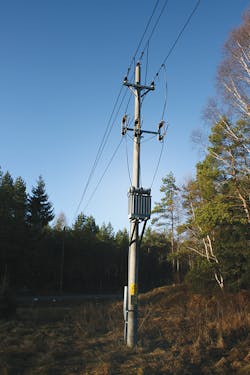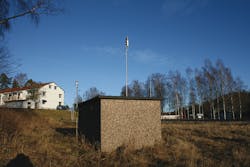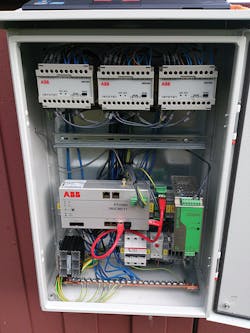Vattenfall Eldistribution AB — a network subsidiary of Vattenfall AB, one of Europe’s largest power utilities — has successfully completed its part of the European smart grid research and development (R&D) project, Grid4EU Demonstrator No. 2. The overall objective of the Swedish utility’s engagement in the Demo2 project was to identify cost-efficient and supplier-independent solutions for the monitoring and control of low- and medium-voltage (LV/MV) networks to fulfill future demands by customers and society in general.
The results of this project showed a potential to reduce the system average interruption duration index (SAIDI) by 5% to 12%. The technical solution from the project is expected to have an impact on the development and adaptation of the next generation of systems and communications and network equipment to be used in coming smart grid implementations with nonproprietary solutions based on common open standards.
Early Smart Grid
For several years, Vattenfall Eldistribution has developed and tested various systems, technologies and methodologies suitable for use in full-scale smart grid implementation on LV/MV networks. Since 2008, the utility’s network customers have been supported by automatic meter management (AMM) technology, including smart meters. After several years of regular operation, several reconfigurations and improvements of the AMM system and smart meters, Vattenfall Eldistribution considers the AMM system a mature and well-performing technology that is fully integrated in ordinary business. The utility is now preparing for a rollout of next-generation smart meters to enable further possibilities.
By being an early adopter of new technologies such as smart meters, conducting several R&D initiatives to test new equipment on the network, and implementing MV supervisory and control data acquisition (SCADA) as well as a distribution management system (DMS) for MV network operations, Vattenfall Eldistribution has achieved a substantial set of tools for the voyage to smart grid realization. One of its main achievements in the energy business has been to enable all opportunities — distributed energy resources (DERs), renewable energy sources and microgrids — that have become possible for customers in the changing energy landscape.
This market change will require real-time access to the LV network. Information from the entire network will enable the utility to develop processes and services to meet future demands of customers. Vattenfall Eldistribution’s first step toward a smart grid was taken when it introduced automatic meter reading (AMR) to its customers several years ago. The Grid4EU Demo2 was considered the second step in implementation and development of AMM technology integrated with a meter data management system (MDMS), SCADA and DMS together with remote terminal units (RTUs) in secondary substations.
Rationale for Demo2
Vattenfall Eldistribution took part in Demo2 with the main objective to demonstrate and validate a possible solution for LV network monitoring by deploying intelligent equipment such as RTUs in secondary substations and using existing smart meters at customer premises to enable more distributed generation while improving customer power quality. Hence, information from two different sources in the same LV network circuit were used and combined in an integrated back-office system environment. The focus was on monitoring and control of the LV network and smart meter data usage to increase efficiency of the control center’s daily network operations, to reduce SAIDI and to improve business operations, such as network planning and optimization, power-quality analysis and field service processes.
As a network operator, it is time to prepare for anticipated future higher requirements of quality of supply by customers. Active customer demands, such as demand-response activities to enable flexibility and electric cars, are anticipated to significantly impact future distribution network availability and power quality.
Demo2 Preconditions
Demo2 was located on the outskirts of the town of Uppsala, Sweden, situated 70 km (43.5 miles) north of Stockholm. The LV (0.4-kV) and MV (10-kV) networks for the demonstration were selected for tests in both urban and rural networks. The tests incorporated more than 100 secondary substations and approximately 10,000 customers.
In general, Vattenfall Eldistribution’s urban Swedish LV network can be characterized as follows:
• Less than approximately 500 m (1640 ft) between the secondary substation and end user
• Commonly ground-built secondary substations with large transformer ratings
• Predominantly underground cabling
• Average number of customers per secondary substation is 21.7.
Vattenfall Eldistribution’s rural Swedish LV network can be characterized as follows:
• Overhead lines with a mix of insulated and non-insulated conductors; however, in certain regions, underground cables are becoming increasingly common
• 1 km to 1.5 km (0.6 miles to 0.9 miles) between the secondary substation and the end customer
• Mainly small pole-mounted secondary substations, with low transformer ratings
• Average number of customers per secondary substation is 14.4.
Demo2 was based on the Swedish market and network conditions, which include full AMR deployment and several years of AMM experience. In this area, Vattenfall Eldistribution provides an excellent platform for dealing with the update of metering and network DMS. Demo2 also is based on market deregulation and market maturation in which Vattenfall Eldistribution gives a privileged position for carrying out smart grid activities. Finally, Demo2 adopts a low-key approach without extensive implementation of complex devices at consumers’ premises, where Demo2 will serve as a realistic and feasible business case for both small and large distribution system operators implementing LV monitoring.
For Demo2, Vattenfall Eldistribution has been in partnership with ABB for the SCADA system, DMS and RTUs; Schneider Electric for AMM and advanced metering infrastructure (AMI); eMeter, of Siemens AG, for the MDMS; and Sweden’s KTH Royal Institute of Technology for special studies.
Demo2 Technical Overview
The technical solution for Demo2 is comprised of three parts, the first of which is RTUs. At secondary substations, RTUs (ABB RTU560CMD11) with attached multimeters (ABB 560CVD03) were connected to each outgoing LV line, with the current on all three phases being monitored using snap-on microcurrent transformers. RTUs are communicating with a built-in general packet radio service (GPRS) modem, using IEC 60870-5-104 protocol. The RTU does not store data continuously. Only selected data, defined by thresholds, is buffered by the RTU before it is sent to the SCADA system (that is, variation from the defined baseline for the parameters included).
The second part of the technical solution is smart meters at customer premises. Schneider Electric smart meters — with functionalities like consumption data, events and alarms, including undervoltage and overvoltage, phase loss and outage — were used. Power line communication with data concentrators in the secondary substations communicated with the built-in GPRS modem using open smart grid protocol.
The final part of the technical solution are the back-end system applications. ABB’s MicroSCADA Pro and DMS600 collected RTU data and Schneider Electric’s AMI platform collected smart meter data. The AMM system was exporting smart meter data, measurement values, events and alarms to eMeter’s MDMS system as well as to the SCADA historian and LV DMS system. All systems were integrated to share data with each other, making the solution dynamic and supportive to increase the process efficiency.
Analysis
Demo2 has demonstrated a LV monitoring solution by using already existing AMM technology together with RTUs in secondary substations to enable improved quality of service and anticipated future usage of distributed generation.
In brief, the operation of Demo2 has shown a successful design of the technical solution in secondary substations, where defined fault cases are accurately identified by RTUs and have the potential to reduce SAIDI by up to 12%. Warnings from both RTUs and smart meters are sent to the overlying SCADA system. These warnings are processed by the SCADA system, announced in SCADA alarm lists and displayed in the DMS.
From alarm lists in the SCADA, system functionality takes the user directly to the alarmed LV line in the DMS, which is clearly marked in the user interface of the network topology. The DMS system can visualize LV networks at different zoom levels, the most detailed at residential meters. In the MDMS, in-depth analysis can be made using data from both the RTUs and smart meters. In short, the technologies used on the MV network can be deployed on the LV network to ensure the quality of supply all the way to the customer.
The Demo2 results conclude the smart grid concept for LV monitoring must be shaped and created differently depending on each actual network situation. For example, customers in rural areas with overhead line connections to the secondary substations are assumed to be more exposed to fault outages in the electricity supply than urban customers supplied by underground cables. Hence, a solution with supervision of the LV line at the secondary substation level may be more appropriate for customers in rural areas, whereas monitoring using only upgraded smart meters may fulfill the initial needs for LV network monitoring of customers in urban areas.
The tested LV monitoring solution is assumed to differ between rural and urban areas, types of secondary substations (such as pole-mounted, larger ground-mounted stations and smaller kiosks) and retrofit installations versus deployment of new secondary substations. Future LV monitoring solutions will contain a combination of different technologies, from only using smart meters to employing advanced equipment in secondary substations and, perhaps, downstream individual LV lines.
Evaluation has shown it is reasonable to assume a large-scale rollout of a LV monitoring solution requires careful analysis of network preconditions in both the MV and LV networks to identify areas where the benefit would be largest.
Demo2 Results
Demo2 has successfully demonstrated the following:
• Efficient smart grid solution for LV monitoring using AMM technology integrated with advanced equipment in secondary substations has the potential to reduce SAIDI by up to 12%.
• Integrating data from both the RTUs in secondary substations and smart meters into two different system platforms — DMS and MDMS — creates opportunities and supports process efficiency for operators in different departments. RTUs in secondary substations make real-time LV network monitoring possible and the use of only smart meters makes near-real-time LV network monitoring possible.
• Technical equipment in both the secondary substation and through the AMM systems are ready for integration in the network processes.
• Methods for identifying suitable locations for this equipment in secondary substations may differ between rural and urban areas, depending on network conditions and prerequisites.
• Solution for improving the customer security of supply and power quality while enabling anticipated increased future usage of distributed generation and electric vehicles.
Vattenfall Eldistribution’s Demo2 project has highlighted the possibility of using smart meters and LV monitoring to facilitate the utility’s distribution network to serve as a reliable cornerstone in the future digitalized energy system.
Next Steps
The Grid4EU Demo2 project showed it is feasible, reasonable and realistic to introduce the digitalized monitoring concept for the LV network. Immediately after the Grid4EU project, Vattenfall Eldistribution initiated a new MV and LV monitoring project that aims to prepare for a real large-scale rollout and implementation of a LV monitoring system and improve the MV monitoring network operations.
The desired functionalities for field equipment and system applications will be developed and tested on a small network area. The selection of equipment includes technical solutions from six manufacturers. In principal, the solutions are the same but differ in detail depending on availability of the functionalities each manufacturer includes within their product portfolio. Such differences, for example, are current and voltage measurement on outgoing LV lines and power-quality measurement from the intelligent devices in secondary substations.
Three IT system suppliers have been invited to demonstrate and make the final tuning of the LV monitoring concept, based on knowledge Vattenfall Eldistribution gained from Grid4EU and other R&D initiatives.
Grid4EU was purely an R&D project, but Vattenfall Eldistribution’s new project has the feasibility to digitalize and make available the entire distribution network for real-time network operations. It will support the utility’s desire to serve its customers better and prepare for the future restructuring of the electricity market, such as more DERs, renewable energy sources and electrical charging stations for electric vehicles.
This new initiative will apply some of the strategies considered during and after the Grid4EU experience. Following are a few examples:
• Careful selection of locations for field equipment in secondary substations; not all secondary substations will be equipped with monitoring devices
• Testing and evaluation of different technical solutions in secondary substations depending on the locations and size of the secondary substations
• Making better use of smart meter technology and upgrading smart meters to improve support for real-time monitoring of the electrical situation at the LV line end point.
The results will be a key input into Vattenfall Eldistribution’s decision on which smart grid strategies to choose. Digitalization of the network will be a necessity for serving customers in the future. ♦
Ulf Ysberg works in the asset development unit of Vattenfall Eldistribution AB in Sweden as an expert in network strategies as well as project manager for larger European Commission-funded projects such as Discern, Grid4EU and Upgrid. He has been working with energy distribution issues since 1982 and has been highly involved in the smart grid transformation at Vattenfall Eldistribution.
Anders Kim Johansson is a senior project manager at Vattenfall Services Nordic AB in Sweden with 20 years of experience in electricity market projects. He has held key positions in projects at Vattenfall Eldistribution during the digitalization transformation of the metering distribution business and smart grid.
Peter Söderström has worked with business development in the energy business since the end of the last century — earlier in the areas of energy efficiency and oil industry, and later with a special focus on the development of the future electrical system, smart grids and especially the network operator’s role. He is currently with Vattenfall Eldistribution AB, where he is responsible for asset development. He is chairman of the Swedish development program for smart grids at Elforsk as well as CIRED Session 6.
Sidebar: Grid4EU Demo2
Vattenfall Eldistribution’s part in the Grid4EU Demonstrator No. 2 project was to develop the monitoring and control of a low-voltage network equipped with automatic meter-reading meters and an advanced metering infrastructure, adding new advanced equipment like remote terminal units in secondary substations, integrating the supervisory control and data acquisition system, distribution management system, metering data management system and automatic meter reading. The project was co-funded by the European Union’s Seventh Framework Programme (EU FP7).









